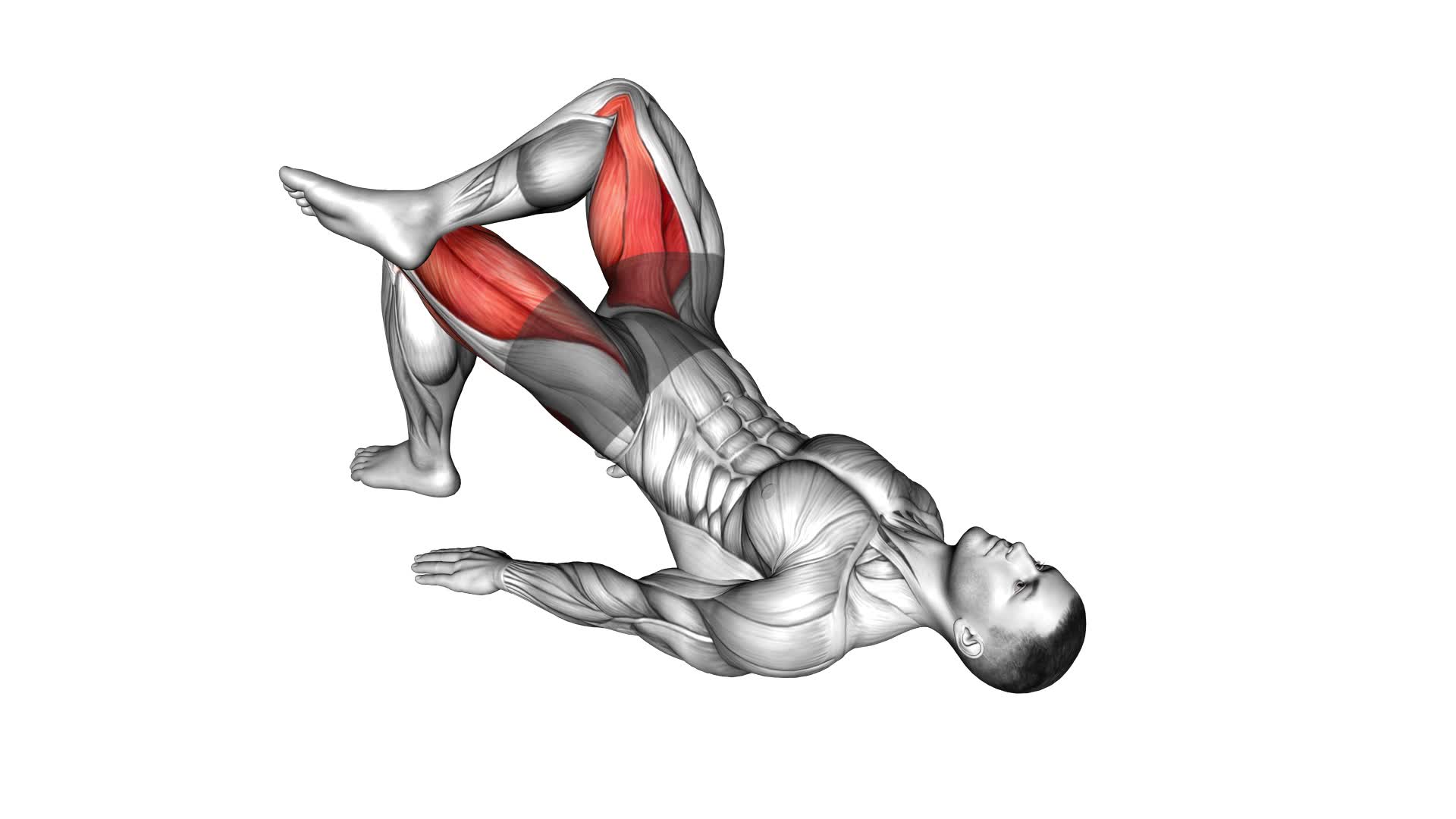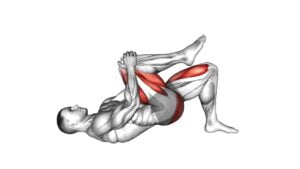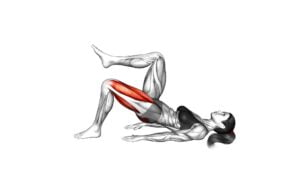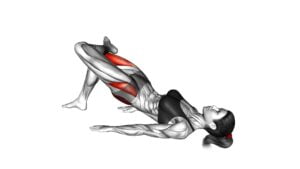Leg Over Knee Glute Bridge (male) – Video Exercise Guide & Tips

Are you looking to strengthen and tone your glutes? The Leg Over Knee Glute Bridge is a perfect exercise for you.
Watch This Exercise Video
In this video exercise guide, you'll learn the proper form and technique to maximize your results.
With variations to challenge your glutes and tips to avoid common mistakes, you'll be able to take your glute bridge workouts to the next level.
Get ready to feel the burn and achieve your fitness goals with this effective exercise.
Key Takeaways
- Leg Over Knee Glute Bridge increases glute activation
- Leg Over Knee Glute Bridge improves hip mobility
- Leg Over Knee Glute Bridge targets the gluteus maximus
- Leg Over Knee Glute Bridge enhances athletic performance and prevents injuries
Benefits of Leg Over Knee Glute Bridge
You can experience increased glute activation and improved hip mobility with the Leg Over Knee Glute Bridge exercise. This exercise specifically targets the gluteus maximus, the largest muscle in your buttocks, making it an excellent choice for strengthening your glutes. By activating and strengthening your glutes, you can improve your overall athletic performance and prevent injuries.
The Leg Over Knee Glute Bridge exercise involves lying on your back with your knees bent and your feet flat on the ground. Place one foot on top of the opposite knee, creating a triangle shape with your legs. From this position, raise your hips off the ground, squeezing your glutes as you lift. Hold for a few seconds at the top before slowly lowering back down to the starting position.
This exercise not only targets your glutes but also engages your core and hip muscles. It helps to improve your hip mobility, which is essential for movements like squatting, jumping, and running. Additionally, the Leg Over Knee Glute Bridge exercise can help correct muscle imbalances and alleviate lower back pain.
Incorporating exercises for stronger glutes, such as the Leg Over Knee Glute Bridge, into your workout routine can have numerous benefits. By regularly performing glute activation techniques, you can improve your overall strength, stability, and athletic performance.
Proper Form and Technique
To perform the Leg Over Knee Glute Bridge exercise with proper form and technique, maintain a stable position by keeping your core engaged and your hips lifted throughout the movement. Here are some key points to keep in mind:
- Common misconceptions:
- One common mistake is allowing your hips to sag or drop during the exercise. This not only reduces the effectiveness of the movement but also puts unnecessary strain on your lower back.
- Another misconception is relying solely on your lower body to lift your hips, neglecting the activation of your core muscles.
- Engage your core:
- Before you begin the exercise, make sure to engage your core muscles by pulling your belly button towards your spine. This will help stabilize your body and protect your lower back.
- Lift your hips:
- As you lift your hips off the ground, focus on squeezing your glutes. This will ensure that you're properly activating the target muscles.
- Maintain alignment:
- Throughout the exercise, keep your knees in line with your toes and avoid letting them collapse inward. This will help prevent any unnecessary stress on your knee joints.
Variations to Challenge Your Glutes
Are you looking for ways to further challenge your glutes during the Leg Over Knee Glute Bridge exercise? If you're ready to take your glute activation to the next level, there are several advanced modifications you can try.
One option is to add a resistance band around your thighs, just above your knees. This will provide additional resistance and intensify the workout for your glutes.
Another variation is the single-leg glute bridge, where you lift one leg off the ground while performing the exercise. This engages your glutes even more and requires greater stability and balance.
For those seeking an even greater challenge, you can try the elevated glute bridge. This involves placing your feet on an elevated surface, such as a bench or step. By elevating your feet, you increase the range of motion and engage your glutes more intensely.
Another advanced modification is the weighted glute bridge, where you hold a dumbbell or barbell across your hips while performing the exercise. This adds resistance and forces your glutes to work harder.
By incorporating these advanced modifications into your Leg Over Knee Glute Bridge routine, you can target your glutes more effectively and take your workout to new heights.
Now, let's move on to the next section and learn about common mistakes to avoid, so you can get the most out of this exercise.
Common Mistakes to Avoid
To ensure optimal results during the Leg Over Knee Glute Bridge exercise, it's crucial to be aware of and avoid common mistakes that can hinder your progress and effectiveness. Here are some common errors in glute bridge technique and how to troubleshoot them:
- Lack of proper alignment:
Make sure your feet are hip-width apart and your knees are stacked directly above your ankles. This will ensure that you're engaging the correct muscles and maintaining stability throughout the exercise.
- Not fully engaging the glutes:
To get the most out of the glute bridge, focus on squeezing your glutes at the top of the movement. This will help activate and strengthen these muscles effectively.
- Allowing the lower back to arch:
Avoid overarching your lower back during the exercise. Engage your core and imagine tucking your tailbone under to maintain a neutral spine position.
- Relying too much on the knees:
Remember that the primary focus of the Leg Over Knee Glute Bridge is on the glutes, not the knees. Avoid relying on the knees to lift your hips and instead focus on using your glute muscles to initiate the movement.
Tips for Maximizing Your Glute Bridge Workouts
For maximum effectiveness in your glute bridge workouts, focus on the alignment and activation of your glute muscles. To maximize results, it's important to ensure that your glutes are properly engaged throughout the exercise. One way to do this is by incorporating resistance into your glute bridge workouts.
Adding resistance can help to increase the intensity of the exercise and target your glute muscles even more effectively. You can do this by using a resistance band, placing it around your thighs just above your knees. As you perform the glute bridge, the resistance band will provide additional tension, forcing your glutes to work harder.
Another tip for maximizing your glute bridge workouts is to pay attention to your form. Make sure that your hips are lifted high enough off the ground and that you're squeezing your glutes at the top of the movement. Additionally, focus on keeping your core engaged and maintaining a neutral spine throughout the exercise.
Frequently Asked Questions
How Many Repetitions Should I Do for the Leg Over Knee Glute Bridge Exercise?
To determine the number of repetitions for the leg over knee glute bridge exercise, consider your fitness level and goals.
Generally, aim for 8-12 repetitions per set to build strength and muscle endurance.
If you're focusing on muscle activation and toning, higher repetitions, such as 15-20, may be more suitable.
Remember to listen to your body and adjust the number of repetitions accordingly.
Always consult with a fitness professional for personalized guidance.
Can I Perform the Leg Over Knee Glute Bridge Exercise if I Have Knee or Hip Pain?
If you have knee or hip pain, it's advisable to modify the leg over knee glute bridge exercise. You can try a variation where you keep your legs straight instead of placing one foot over the other knee. This will reduce the strain on your joints.
Additionally, it's important to avoid common mistakes such as arching your back or lifting your hips too high. Remember to maintain proper form and listen to your body to prevent any further discomfort.
Is It Necessary to Use a Resistance Band for the Leg Over Knee Glute Bridge Exercise?
No, it isn't necessary to use a resistance band for the leg over knee glute bridge exercise. However, incorporating a resistance band can provide additional benefits such as increased resistance and activation of the glute muscles.
It can also help add variety to your glute bridge workouts.
Can the Leg Over Knee Glute Bridge Exercise Help With Lower Back Pain?
The leg over knee glute bridge exercise can be beneficial for relieving lower back pain. By engaging your glutes and core muscles, this exercise helps to strengthen and stabilize your lower back. It also improves overall strength and stability.
To modify the exercise for different fitness levels, you can increase or decrease the range of motion or add resistance with a band. Remember to maintain proper form and consult with a fitness professional if needed.
Can I Do the Leg Over Knee Glute Bridge Exercise Without Any Equipment?
Yes, you can definitely do the leg over knee glute bridge exercise without any equipment.
This exercise is great for targeting your glute muscles and strengthening your lower back.
It can also help improve your balance and stability.
If you don't have access to equipment, there are alternative exercises you can do to work the same muscle groups, such as hip bridges or glute bridges with your feet on the ground.
These exercises provide similar benefits and can be just as effective.
Conclusion
In conclusion, the leg over knee glute bridge is a highly effective exercise for targeting and strengthening the glute muscles.
By maintaining proper form and technique, you can maximize the benefits of this exercise and avoid common mistakes.
Additionally, incorporating variations into your workouts can help challenge your glutes and keep your routine interesting.
Remember to always listen to your body and adjust the intensity as needed to ensure a safe and effective workout.

Author
Years ago, the spark of my life’s passion ignited in my mind the moment I stepped into the local gym for the first time. The inaugural bead of perspiration, the initial endeavor, the very first surge of endorphins, and a sense of pride that washed over me post-workout marked the beginning of my deep-seated interest in strength sports, fitness, and sports nutrition. This very curiosity blossomed rapidly into a profound fascination, propelling me to earn a Master’s degree in Physical Education from the Academy of Physical Education in Krakow, followed by a Sports Manager diploma from the Jagiellonian University. My journey of growth led me to gain more specialized qualifications, such as being a certified personal trainer with a focus on sports dietetics, a lifeguard, and an instructor for wellness and corrective gymnastics. Theoretical knowledge paired seamlessly with practical experience, reinforcing my belief that the transformation of individuals under my guidance was also a reflection of my personal growth. This belief holds true even today. Each day, I strive to push the boundaries and explore new realms. These realms gently elevate me to greater heights. The unique combination of passion for my field and the continuous quest for growth fuels my drive to break new ground.







